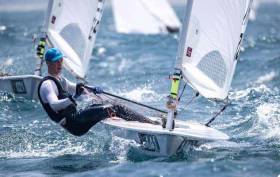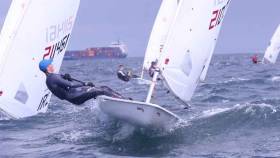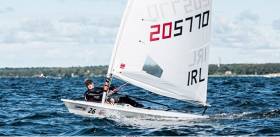Displaying items by tag: Ewan McMahon
Howth Laser Sailor Ewan McMahon Battles on Towards Olympic Qualifier
In Japan, public opinion may be divided as to whether this summer’s already postponed Tokyo Olympics should be postponed even further, or indeed completely cancelled. But completely focused athletes such as Laser sailor Ewan McMahon of Howth have no choice other than to keep battling on to see if they and Ireland can secure a place in Tokyo in July, and this week he has been in high-powered action off Malta in some seriously big waves.
The plan is to go on to Lanzarote in the Canaries at the end of the month for more competition, and then there’s further diversion for a challenge on Croatia in the buildup to the final Olympic qualifier in Hyeres in April.
Irish Laser Sailors Lynch & McMahon Make Top Ten of Italian Olympic Week Despite Early Exit
Two of Ireland's three Olympic men's Laser campaigners finished in the top ten of the Italian Olympic Week fleet today even though they didn't manage to sail the final race in Follonica.
Howth's Ewan McMahon closed the gap on the National Yacht Club's Finn Lynch when he moved up from 12th to finish tenth overall, just three places behind the 2016 Rio rep. Ballyholme's Liam Glynn finished 21st in the 88-boat fleet.
It all adds up to an exciting Irish contest where the prize will be a place at the Tokyo Olympics if a nation berth can be won by any of the three.
As Afloat reported last November, before any Irish Olympic nomination can be conferred at least one of the three must win one of two final European Olympic slots remaining but that Olympic qualifying regatta will not now be held until 2021.
Racing was cut short for the Irish trio in Italy today as they ditched the last race of the series this afternoon in order to catch a flight home before Italy closed to Ireland as a 'green listed' country in the latest round of COVID travel restrictions.
Both American Charlie Buckingham and Brazilian Robert Scheidt managed to overhaul overnight leader Guatemalan Juan Ignacio Maegli for the overall win, according to provisional results issued.
Download results below
The next event for the Irish Laser men is the Europeans in Poland, Gdynia, 6th to 12th of October.
Finn Lynch Lying Seventh at Italian Olympic Week, McMahon 12th & Glynn 15th in 88-Boat Laser Fleet
The Irish Laser men who are in a three-way battle for 2021's single Tokyo Olympic berth resumed their fight after the COVID hiatus at Italian Olympic week in Follonica this weekend.
With six races sailed, the National Yacht Club's Finn Lynch, the 2016 Irish Olympic representative, is seventh in the 88-boat fleet, five places ahead of Howth Yacht Club's Ewan McMahon. Ballyholme's Liam Glynn is lying 15th.
Unfortunately, the Irish trio spent a fruitless day afloat today with no wind to even get one race sailed. However, stronger scirocco winds are forecast to complete the series tomorrow with an early start.
Guatemalan Juan Ignacio Maegli (6 points) leads from American Charlie Buckingham (7) with Brazilian Robert Scheidt (8) only two points off the lead.
As Afloat reported last November, before any Irish Olympic nomination can be conferred at least one of the three must win one of two final European Olympic slots remaining but that Olympic qualifying regatta will not now be held until 2021.
The trio is joined in Italy this week by Radial teammate Annalise Murphy who leads her 41-boat division.
Finn Lynch v Ewan McMahon Battle at UK Laser Event
For Irish Olympic Laser fans there was a taste of what's to come next season in the mens Laser Class last weekend in Portland Harbour on the English South Coast. Irish Tokyo trialists Finn Lynch (23) and Ewan McMahon (20) finished only a point apart at a UK World and European Qualifying event.
The pair, along with 2018 Irish champion Liam Glynn, are still seeking a nation berth after the disappointment of the Worlds in Japan in July. There's one chance left and if successful in Genoa's World Cup round next April it will produce a three-way trial between them for the single Olympic spot.
And if the weekend results from the Dorset coast are anything to go by, Lynch of the National Yacht Club and McMahon of Howth Yacht Club appear to be already locked in a battle royal.
It is McMahon's first senior season in the Laser and already the 2016 Radial world silver medalist is challenging the 2016 Rio Rep, Lynch.
130 Laser sailors raced under blue skies in Portland Harbour with some great breezes, even if shifty conditions led to up and down results for some.
Glynn looked completely off the pace in 16th place after counting a DNS and a DNC in the Standard fleet but Lynch and McMahon finished fifth and sixth respectively and were only a point apart overall after six races. Results are here
Also competing in Portland was 2018 Masters World Champion Mark Lyttle who finished 20th.
More on the Q system for Ireland in the mens Laser is here
The National Yacht Club's Finn Lynch stays top five overall in the Laser class as the split from qualifying to finals racing arrived yesterday at the Trofeo Princesa Sofia Iberostar. The strongest breeze of the regatta so far arrived as if on cue. The step up to gold fleet racing can be a blessing or a curse but for Lynch, who is having a stand out performance this week, it is definitely another blessing that follows on directly from a similarly stellar performance last January in Miami.
Norway’s Hermann Tomasgaard still leads the men, rallying to a ninth after 23rd place wobble in the first Finals race. Lynch had a 14th and a 23rd place which he discarded as his worst score to date.
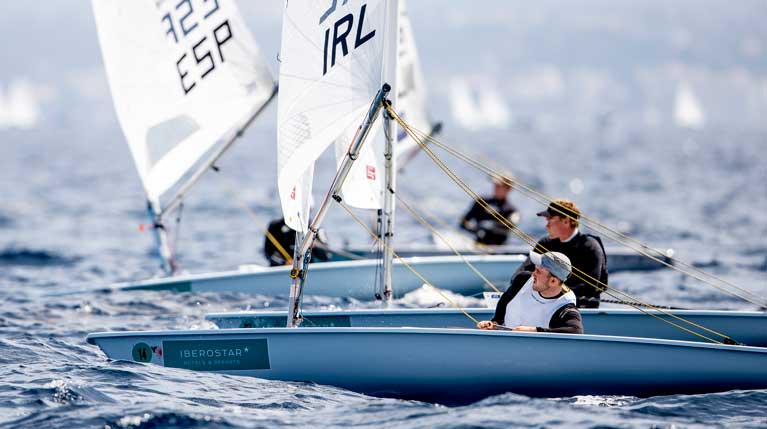 Finn Lynch is in the to top five of the 170 boat Laser class in Palma Photo: Sailing Energy
Finn Lynch is in the to top five of the 170 boat Laser class in Palma Photo: Sailing Energy
Howth's Ewan McMahon Makes Gold Fleet
In another stand out performance for Ireland, Howth Yacht Club's under-21 sailor Ewan McMahon made the gold fleet cut at only his second attempt at senior level. In fact, McMahon was racing alongside Lynch at one stage before finishing in the 20s in their 60-strong gold fleet. The 2016 Laser Radial World silver medalist has embarked on his own Olympic campaign after a string of Laser successes at youth level.
Adding to the strong showing for the British team overall today, Lorenzo Chiavarini won the second contest and lies second. Racing continues today.
Full results are here Check out all our Irish Olympic sailing coverage in the build-up to Tokyo 2020 here
Bronze For Belfast’s Liam Glynn At U21 Laser Worlds
#Laser - Ballyholme’s Liam Glynn added to a stellar weekend for Irish sport when he won bronze at the U21 Laser Worlds in Poland this afternoon.
The phenomenal result saw the former Topper world champion come out tops in the sixth qualifier and score three straight third-place finishes in the eighth, ninth and 10th races of the week.
Two other Irish Laser sailors made the Gold Fleet at Gydnia, with Johnny Durcan placing 40th and Ewan McMahon 44th.
In the women’s Laser Radial competition, Belfast’s Sally Bell bowed out after four races to place 70th overall.
It was the biggest ISA Youth Sailing Pathway Nationals yet seen, and the 2017 Championship at Ballyholme Yacht Club – 190 boats, 208 sailors – lived up to and beyond expectations in a variety of sailing conditions between 20th and 23rd April.
It was the Battle of the Titans in the Laser Radials that inevitably drew most attention. For the top sailors - with the cut-off age hovering in the background - it may be their final appearance on this hugely significant home stage. For Ewan McMahon of Howth, Silver Medallist at the Laser Radial Worlds in Dublin Bay in 2016, it was a series with challenges from every direction. The word was that serious rising stars were emerging from the hotbed of junior sailing in Rush, while Johnny Durcan of Royal Cork – All-Ireland Junior Champion 2016 – had spent part of the winter in Australia honing his Laser racing skills.
Ewan McMahon sailed a masterful series. With some flukey conditions, he wasn’t always top of the leaderboard, but he was inevitably there or thereabouts. And when the wind came in with sufficient vigour to give his tall slim frame its natural advantage, he took control to emerge as overall winner by a clear margin in a textbook exhibition of well-managed series racing.
Liam Glynn & Aoife Hopkins Both Fourth At Laser Youth Euros, Ewan McMahon Retires from Tallinn Regatta Due to Illness
Ballyholme Yacht Club's Liam Glynn, the one time leader of the Laser Radial Youth European Championships in Estonia, finished fourth overall in the 69–boat gold fleet yesterday. The championships, sailed in the Bay of Tallinn, was raced over eight races with one discard and a variety of sailing conditions. No racing was possible yesterday due to lack of wind.
In the gold fleet, Ireland's Conor Quinn was 65th and Peter Gilmore 69th, according to the official results HERE.
Earlier in the series, overall results for Ireland’s World Youth silver medallist Ewan McMahon indicated the Howth Yacht Club sailor was still competing in Tallinn when in fact he had been forced to withdraw due to illness. Ewan was hospitalised in Estonia last Thursday before returning home to Ireland on Saturday.
In the girls fleet, McMahon's club–mate Aoife Hopkins finished fourth on equal points with the bronze medallist, Carolina Albano. Official results HERE.
At the same time, another Irish Laser youth team is competing at the Laser U21 World Championships in Kiel, Germany.
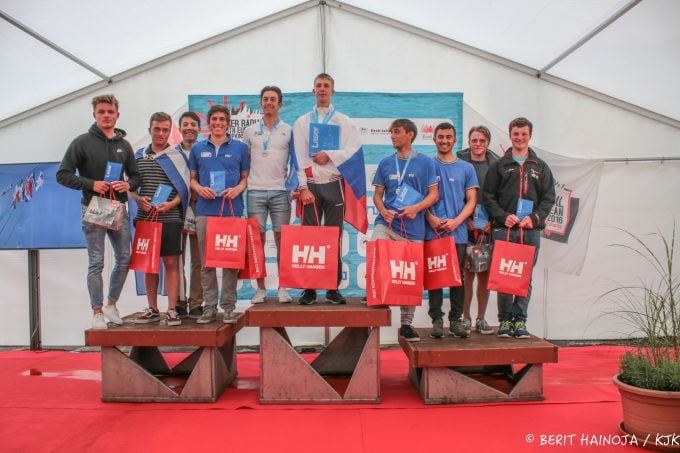 The U19 Boys Top 10 at the Laser Radial Youth European Championship 2016, Tallinn, Estonia. Ballyholme's Liam Glynn is pictured extreme right. Photo Berit Hainoja/KJK
The U19 Boys Top 10 at the Laser Radial Youth European Championship 2016, Tallinn, Estonia. Ballyholme's Liam Glynn is pictured extreme right. Photo Berit Hainoja/KJK
Final Race report by organisers:
Today was the last day of the 2016 Laser Radial Youth European Championships in Kalev Yacht Club for U17 and U19 age groups. Weather was tricky also on the last day. If, until so far, we had struggled with too much wind, then the situation today was the opposite and after a long wait no races were held, despite many attempts. European champions in youth U17 and U19 groups were based on the results announced yesterday evening. Both girls’ European champions are from Germany: Hannah Anderssohn in U19 and Laura Schewe in U17. Daniil Krutskikh from Russia is the new European champion both in boys’ U19 and U17 groups.
Laura Schewe from Germany, who was leading the U17 group from the very first day, was very pleased with her performance and the whole regatta. „I had to concentrate very hard not to let competitors pass me. I was sixth overall and my peers were also racing very well. Especially Valeriya Lomatchenko from Russia who finished eighth in overall. The race committee did a very good job and we could enjoy some fair and honest sailing. Tallinn is a beautiful city and we loved our time here,” commented Laura after the prize-giving ceremony. Girls’ silver in U17 belongs to Valeriya Lomatcenko and bronze went to Wiktoria Go Biowska from Poland.
U19 European champion Hannah Anderssohn, who finished first four times, third three times and sixth once, was also overjoyed: „Conditions were very complicated but all races were very fair as the race committee did a great job. I was in the lead yesterday and felt very optimistic about today as I had been sailing a stable series and I did not care about the second discard. I would like to thank my competitors for a great regatta – it was really nice here and I’m very pleased about winning.” Girls’ U19 silver went to Louise Cervera from France who was six points behind the winner. Carolina Albano from Italy, who had been leading the regatta for most of the time, lost her position on the last day of races due to an abandoned race because of a broken mast. She finished third, ten points behind the winner.
The only Estonian girl Maris Seersant from Tallinn Yacht Club finished 23rd being very content with her sailing: „I have not been sailing Laser Radial very long yet and therefore I’m quite happy about my even series and position in the middle of the fleet. As we had really strong winds most of the time, everyone dreamed of quieter days which never came. However, I’m very glad I could race such among such strong competition at a home regatta.”
The first three among U19 boys all finished within three points, whereas the second and third have an equal score. Daniil Krutskikh from Russia, who became Laser Radial U17 world champion a couple of weeks ago in Ireland, was quite unreachable for his competitors in Tallinn also. He finished first four times out of eight races, which meant that the rest, 9th, 22nd and 29th result, did not stop him from winning the title both in U19 and U17 groups. „The entire week we had to race in strong winds and big waves where is hard to handle the boat, but I have practiced these conditions a lot in Italy under my dad who is my coach – this gave me good chances here too. The competition in Ireland at the Worlds was stronger, unfortunately my main competitors from Spain and the Netherlands did not come to Tallinn – this is why I had more chances to take the title in U19 too. I really enjoyed the regatta here and I’m overjoyed about the results” commented the new European champion happily. Daniel Whiteley from England was three points behind him and finished second in U19.
Bronze went to Paolo Giargia from Italy who had the same amount of points. The only Estonian in the gold fleet was Tavo Annus who finished 41st overall.
The silver on U17 went to Milo Gill-Taylor from England and Wojciech Klimaszewski from Poland earned bronze.
The closing and prize-giving ceremony was held in Kalev Yacht Club marina. The best were greeted and awarded by PRO Viljar Sepp, a former Olympic medalist in 470 class Tõnu Tõniste, Kalev Yacht Club representatives and the Vice President of the Estonian Olympic Committee. Macrino Macri, Vice President of EurILCA, expressed his sincere gratitude to the organisers for an amazing regatta and superb teamwork. „The passion and soul you put into organising this event is enviable. Despite tricky weather we managed eight wonderful races and, in the name of EurILCA, I would like to thank Kalev Yacht Club for this great regatta!“
Regatta director Indrek Ilves commented after the regatta that successful major event is the best advertisement for both the Kalev Yacht Club and Estonia in general. “In addition to the nearly 200 thousand euros that the 350 guests of the regatta leave here, it is also an amazing opportunity for the young sailors to experience sailing in such a big and strong fleet. Every successful regatta makes it easier to get more major events to Estonia.”
Ewan MacMahon Is 'Sailor Of The Month (Racing)' For July
The conditions for the KBC Laser Radial Worlds in Dublin Bay could be tough. Not because the weather was severe, but because the wind kept taking off just when everyone hoped they’d settled into some good racing. Frustration takes it toll on competitors and Race Officers alike, and when it was reckoned that the only way to make a real series out of it was to start getting the fleet afloat at 0800 hrs on the final Saturday and put in three races while conditions suited, the pressure was stepped up even further.
In such situations, some get fussed, some stay cool, and some actually seem to thrive. Ewan MacMahon (17) of Howth fitted in somewhere between the latter two categories. While American Henry Marshall seemed assured of the Youth Gold, MacMahon was going so well that his most enthusiastic supporters felt he might sail straight up through the Silver and on into Gold.
That was expecting a bit much, but his winning of the Silver Medal was done in real style to emphatically confirm Ewan MacMahon as “Sailor of the Month (Racing)” for July.
In a dramatic conclusion to this week's three world–title Laser Radial dinghy event, Ireland's Ewan MacMahon took the boys silver medal challenging American Henry Marshall for gold in a cliffhanger final 11th race off Dun Laoghaire this afternoon.
The decision to launch early at the Royal St. George Yacht Club bore fruit this morning as three more races in the week long series were completed, bringing the curtain down on the biggest regatta sailed in Ireland this year.
Top 2 Boys Henry Marshall (USA 209071) & Ewan McMahon (IRL 210101) being hoisted up & carried ashore! #KBCRadials16 pic.twitter.com/5WYcJHGjhI
— KBC Radial Worlds (@LaserWorlds2016) July 30, 2016
In a very positive test of the depth of talent of Irish youth sailing, five Irish boys made the gold fleet cut in the largest 229–boat fleet. Royal Cork's Johnny Durcan was eighth, the host club's Conor O'Beirne was 12th, Liam Glynn was 31st and Ronan Walsh 47th.
Marshall – ninth at the 2015 championships – lifted the World trophy in Dun Laoghaire in style, clearly benefiting from his year out of High School spent as training partner to America's Rio Radial Representative, Paige Railey.
Wow competitors lift Ewan McMahon (Howth) as he wins Silver* @LaserWorlds2016 World Championships (*prov) pic.twitter.com/DqOik2ku9T
— Gordon MRM (@gordon_mrm) July 30, 2016
Although Marshall described this week's Dublin Bay conditions as 'tough as sailing gets', the Boston 18–year–old managed with a very consistent series, (counting eight results in the top five) to lead the boys fleet from start to finish. He slipped today in a tricky race nine, however, discarding a 33. In a plucky finish, and with two races left to sail, the Irish Connacht champion succeeded in narrowing the overall points gap.
By the final race, if the Howth Yacht Club sailor had beaten Marshall, and he had finished outside the top seven, the title would have gone to Ireland but in the end, it went Marshall's way by a margin of five points. Third overall was Spaniard Rafael de la Hoz Tuells some 11–points adrift.
McMahon adds World Silver to last year's European Silver in a stand–out season for the Dubliner. He returns to action in just over a fortnight at the Laser Radial Youth Europeans in Tallinn, Estonia.
One of the first to congratulate McMahon when he came ashore at the Royal St. George YC slipway was Ireland's only Olympic sailing medalist, David Wilkins. The 1980 silver medal winner helmsman was one of a large number of volunteer sailors who helped to run the 48–nation event at Dun Laoghaire Harbour.
In the girls 76–boat fleet, Australian Zoe Thomson was the winner, eight points ahead of one time leader Caroline Rosmo of Norway. Third was Louise Cervera of France. Sixth was Dun Laoghaire's Nicole Hemeryck of the National Yacht Club. Howth's Aoife Hopkins was 11th.
In the mens 42–boat fleet, after 12 races sailed, Poland's Marcin Rudawski was the overall winner. Second was Slovakia's Nik Pletikos and third Brazil's Manzoli Lowy. Ireland's Daragh O'Sullivan was fourth and one time fleet leader Ronan Wallace of Wexford Harbour sixth.
Overall results are here





























